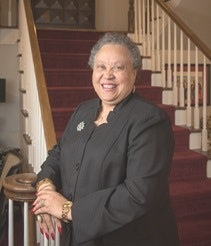Colleges and universities will be trumpeting their horns over the next few months, celebrating the beginning of another school year filled with lots of promise and anticipation for many among administrators, teachers, behind-the-scenes staffers and students.
The excitement masks a growing sense of anxiety, however, especially among historically Black colleges and universities (HBCUs), as warning signs abound for many small and mid-size institutions.
 Dr. Belle S. Wheelan
Dr. Belle S. WheelanOverall, enrollment in higher education continues to decline at many small and mid-size schools across the country, says higher education analysts who note that many institutions are heavily dependent upon tuition, federal student aid and philanthropic donors.
Meanwhile, a growing chorus of voices is saying higher education, as it was widely known and accepted in the last century, is steadily diminishing. Their declarations are growing with few high-profile people of influence urging a shift from the direction of the cliff.
Trump administration education officials are carefully pushing HBCUs that are on the financial edge to consider merging or taking other bold cost-cutting steps, knowledgeable higher education administrators say. The topic is said to be at the centerpiece of several HBCU meetings set to be held this fall in Washington, D.C.
There are many who suggest the merger-consolidation-closure advocates abandon that push and instead embrace efforts to invest more in HBCUs, as was the case when they began a century and a half ago.
“We have to be concerned,” says Dillard University president Dr. Walter M. Kimbrough, noting the tough time facing HBCUs call for people with influence to do more than suggest the institutions have largely served their purpose and their chapter in history should be turned.
“It’s tough for everybody,” Kimbrough says, adding that there are a wide array of institutions facing closure regardless of their historical roots. “When there’s a squeeze on the system, it’s a little harder for us. We have to have a greater sense of urgency.”
Kimbrough has been president of the small, private Louisiana four-year college for more than seven years.
Mergers should ‘make sense’
“You don’t start with mergers when you are having challenging times,” says attorney Lezli Baskerville, president of the National Association for Equal Opportunity in Higher Education (NAFEO), the long-standing trade association of leaders of the nation’s HBCUs.
“When you talk about mergers, it has to make sense,” says Baskerville, adding that more than 80 percent of HBCU dollars are public dollars, an income pipeline that has dramatically dried up over the past decade. Alumni and other non-government sources have not filled the rapidly expanding funding needs gap, she says.
In Delaware, where more than 100 HBCU fundraisers gathered at Delaware State University for this summer’s annual HBCU Philanthropic Symposium, the need to step on the fundraising gas was acknowledged. There was little enthusiasm among those set to attend the gathering for thinning the ranks of HBCUs.
“Our institutions are too valuable to close any of them,” says Dr. Vita Pickrum, vice president of institutional advancement at Delaware State and president of the university’s small foundation. “We do need to look internally to see how we can operate more efficiently with the operations we do have and look at sustainability,” said Pickrum, echoing peers.
 Lezli Baskerville
Lezli BaskervilleRepeating a thought offered earlier by Kimbrough, Pickrum says fellow HBCU fundraisers need to look externally to sharpen the message of their institution.
“Unless they see value, the chances of them supporting any forum will not happen,” says Pickrum. “People want to know if we are a good investment.”
Pickrum and others acknowledge the nation is engaged in a dizzying ride that has troubled much of higher education, with HBCUs feeling the bite even more based on their roots.
Dr. Belle S. Wheelan, president of the Southern Association of Colleges and Schools Commission on Colleges (SACSCOC), says a variety of factors are converging at one time it seems, resulting in all kinds of new challenges for higher education.
On the demographic front, the nation is simply not producing as many children as past generations, causing the overall population of college-age students to decline, she says. Today, African-Americans have many more choices of higher education institutions than they had 50 or 100 years ago. Currently, less than 20 percent of African-Americans start their college years at HBCUs, compared to more than 90 percent in the decades of racial segregation.
On the institution front, two-year community colleges are aggressively competing for high school students, offering low-cost or free two-year associate degrees with the increased use of “articulation” agreements ensuring more can transfer to a four-year college for their last two years of study and a bachelor’s degree. While community colleges raise their game competing for students, for-profit institutions have steadily attracted a growing number of historically Black college prospects.
Wheelan says today’s generation is putting pressure on institutions to have more “bling” across the board, from “better faculties” to modern dormitory buildings with year-round air conditioning and exercise facilities, cutting-edge Internet connections and meal services that are far more than the traditional cafeteria-style services.
“Alumni giving does not match the need of these institutions,” says Wheelan, adding that “the demand for services list grows each school year.”
“Many colleges have more bling” from academic programs, to better facilities and auxiliary services, says Wheelan. Today’s college students “are making choices for comfort as much as they are planning for the future,” she adds.
Fold all those elements into state legislatures that until recently were pinched for funds for state colleges and downgraded funding priority for higher education and HBCUs are fighting for their lives along with peer institutions that have no such history.
“It’s not just a HBCU problem,” Whelan says. “It’s just exacerbated at HBCUs, they don’t have the bling,” she adds.
 Dr. Walter M. Kimbrough
Dr. Walter M. KimbroughSome states, like Georgia, have tackled the myriad challenges cited by Pickrum, Whelan and others by consolidating many of its state-controlled colleges in a very open-methodical way. No institution, regardless of its racial roots, has been spared.
In a plan launched in 2012, the Georgia Board of Regents pursued a “Principles of Consolidation” agenda by which it made a system-wide examination of its 35 institutions of higher education. In the process, it opted to consolidate institutions that were losing enrollment and could do better pairing their efforts.
Today, Georgia boasts 26 state-controlled colleges and universities, including consolidation of well-established historically White and Black institutions. The process was painful in many respects, as many older Georgians were reminded of the widespread displacement of Black teachers and principals during the desegregation of elementary and secondary schools in Georgia and other Southern states.
The state cut its annual higher education costs by some $32 million in the process, with elimination of jobs and other overlapping back shop work. Most of those displaced were able to find new jobs, as the transition was not overnight. Still not every issue tackled in the consolidation process was a seamless one.
“The names issue are probably the most sensitive,” says John Fuchko, the vice chancellor for organizational effectiveness at the Georgia Board of Regents. Indeed, preserving the legends and labels of the institutions that were closed became a front and center issue. In the end, some buildings, campuses, programs or other items were named to make sure the closed institution was not erased from the state’s and institution alumni history, Fuchko says.
Some states with a growing list of ailing (enrollment declines and income) state institutions, like Pennsylvania, are watching the Georgia move, Fuchko says, hastening to add that he knows of no states that are actively seeking to embrace the Georgia approach.
Issues likely to be debated
Whether there is any united appetite in the HBCU community to pursue such ideas is an open question likely to be widely debated this fall at the planned White House Conference on HBCUs and the fall gathering of the Millennium Institute for academic leaders. While some HBCUs are strong and vibrant by every SACSCOC measure, many are vulnerable, based on developments in the last few decades. Yet they are determined to survive, as they have since opening their doors just after the Civil War.
St. Paul’s College in Virginia and Alabama’s Concordia College have formally and officially shut their doors. Several institutions, such as Knoxville College in Tennessee, Barber Scotia in South Carolina and Georgia’s Morris Brown, have lost their accreditation from the prestigious SACSCOC. Still, they refuse to shut their doors. The institutions consider themselves in business, if only by name for the moment, as they try to raise funds and recruit additional students.
There are no fixed numbers of precisely how many HBCUs are still vibrantly open, according to non-partisan organizations that keep track of the institutions. For sure, most have minimal funds in reserves of a few million dollars and some have enormous operating deficits. Less than 10 HBCUs have an endowment of more than $50 million.
Still, ardent supporters of HBCUs remain optimistic about the future, arguing that the nation still needs them.
This article appeared in the Aug. 9 issue of Diverse.





















